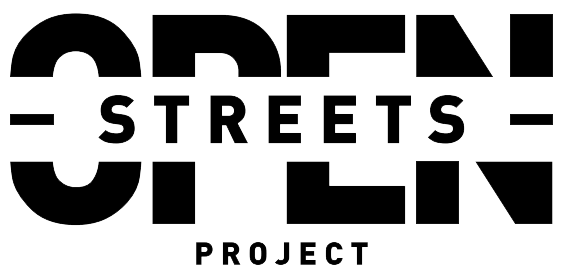Where to Begin?
Figuring out where to begin can often be the toughest part of starting an Open Streets program. There are a lot of wheels to start setting in motion and a lot of pieces to start pulling together. To help you get things rolling, we have described the key steps you’ll need to take to get your program through the initial stages of its existence. The following steps will overlap and interlock with each other. They most likely won’t happen one after another but will support and inform each other.

Building a Strong Team
Bringing together the right people is a critical step in the process of creating a successful Open Streets program. Open Streets programs are often born around a lunch table or in the twitter-sphere. Like-minded people come together to create a program they all understand and believe in. While chances are these people will make up the majority of your team, you need to think strategically about the roles you need to fill, and who should feel them. You may need to look for people with specific skills, political connections, or networks that will help you develop the strongest possible program.
While the composition of teams may vary from city to city, the basic structure or key tasks of Open Streets teams can be seen below. During the early months or years of your program it is not uncommon for people to wear multiple hats- e.g. the Marketing and Communications lead may also be the Financial Management lead- the important thing is to identify key roles and responsibilities.
Managing Director
Roles and Responsibilities:
- Oversee overall program management and operations of the areas of responsibility listed below.
Community and Political Outreach
Roles and Responsibilities:
- Schedule and liaise with key community groups and mid-level stakeholders like BIAs, Resident Associations, and Neighbourhood Associations
- Ensure local political offices are kept informed of the program details
- Define overall strategy for addressing mid-level stakeholder concerns and requests
Volunteer Services
Roles and Responsibilities:
- Define the overall volunteer strategy
- Research different methods for recruiting volunteers
- Create a strategy that trains, manages, and communicates with volunteers
- Oversee each program date’s volunteer function
Communications and Marketing
Roles and Responsibilities:
- Create a communication strategy, which includes key messages, media relations, social media and website management
- Manage the creation, production, and distribution of marketing materials
- Liaise with media
Operations and Permitting Management
Roles and Responsibilities:
- Manage and deliver all operational needs
- Assist in developing a budget with other team members
- Manage all permitting related issues
- Deal with route issues and traffic management plan
- Manage all critical service providers such as Police Service, EMS, and Fire Service
Evaluation
Roles and Responsibilities:
- Design and implement evaluation strategy
- Oversee data gathering during program hours
- Develop post-event evaluation reports
Finance
Roles and Responsibilities:
- Budget oversight and management
- Liaison with legal counsel
- Manage and file all relevant finance documents with the appropriate entities
- Assist in developing a budget with other team members
Sponsorship and Funding
Roles and Responsibilities:
- Create various forms of sponsorship presentations for potential funders
- Research, identify and approach potential source of funding
- Manage, cultivate sponsor relationships

Developing Your Vision
Once you have assembled your team, you need to define your mission, values, goals and long term vision. The most successful programs incorporate four key elements:
1) An Iconic Route
If you want people to come out to your program, you need to take them someplace they want to go. Iconic streets, like Park Avenue in New York, are popular destinations that naturally draw people out. The best Open Streets programs take advantage of this and utilize major streets as the main corridors of their route. The routes selected and opened to people during an Open Streets program should be strategically chosen to include these iconic streets within the community, not just bridges, parkways or trails. Main Streets that include restaurants, cafes, shops, and services serve as the backbones of the route, with smaller intersecting streets open to people to connect to different social, economic, and ethnic areas of the city.
In determining the length of the route, it is key to remember that you need to attract and retain the interest of walkers, runners, and cyclists alike. While shorter routes may work for those on foot, cyclists can easily lose interest if they can ride end to end in 10 or 15 minutes. We suggest a route no less than 3 miles or 5 kilometres for smaller cities, and 6 miles, or 10 kilometres for mid to large cities, with the goal of expanding that route year after year to connect to as many people as possible.
It is also important that the route stay consistent so that residents and vehicular traffic can anticipate the street opening each week/month/year. If residents can depend on knowing that the program is taking place at the same time and on the same day every week or month, they can plan their routines accordingly.
Want to delve even further into route planning? See our in-depth Planning Your Route resource.
2) Regular Frequency
Ensuring the program takes place with predictable regularity is just as important as ensuring the route stays consistent. With predictable regularity, participants are able to plan their attendance in advance, and change their behaviour to be physically active on a regular basis. The best programs in the world, such as the program in Bogotá, Colombia and Guadalajara, Mexico, take place every Sunday of the year.
Identify local attractions like libraries, museums, community or recreation spaces, parks, entertainment centres, or bustling business districts and connect them to the spine of your route as these are natural attractions, usually with existing activities to highlight.
3) Activity Hubs of Complementary Programming
Your regularly occurring program and iconic route are the main ingredients making up a successful Open Streets program. Programming is the cherry on top, the icing on the cake. Programming Hubs are areas of programmed activities in publicly accessible spaces along the route that focus on offering physical activity classes such as dancing, yoga, aerobics, and hula-hooping, or other wellness-oriented activities like nutritional education, heart rate measurements, building community connections and healthy food options. These activity hubs should be spaced out along the route, as they enhance the health focus and encourage participants to move throughout the program.
For a deeper dive into programming your route, take a look at our Complementary Programming resource.
4) Free and Accessible Participation
This is the lynchpin of any Open Streets program, underpinning the other core concepts. The best Open Streets programs are designed to be inclusive of all ages, abilities and socio-economic circumstances. All users, including walkers, runners, cyclists, rollers, strollers, and those with mobility devices should feel welcome. The programs are barrier-free, with no user fees to participate in the street opening, or any of the complementary programming.
With these four elements forming the basis of your vision, you can start to tailor to the needs of your city and communities. While Open Streets programs are at their core a physical health and recreation program, they are also exercises in social integration, opportunities for economic development and platforms for testing out new cycling and pedestrian oriented infrastructure. Depending on the needs of your city, you can choose to tailor your route and programming activities to address those concerns. Use those priorities to inform your dream ‘pie in the sky’ vision and incorporate those goals into your program pitch and materials.

Pitching Your Idea
In order to create a lasting, sustainable Open Streets program for your city, it is in your best interest to have support from diverse stakeholders, and to begin building that support early in the process. Getting people on board with the concept of your program as early as possible will not only help get things rolling, but it will help later in the process as well with getting the word out and showing community support at town hall and city council meetings. Early supporters can also be helpful for turning critics into enthusiasts!
So, you need to pitch your idea! To help with that process, we suggest creating two key pieces to share with potential stakeholders:
- A brief presentation
- 1 page information fact sheet that can be distributed to stakeholders
Both of these should include the following information:
What is an Open Streets Program? What will/could the Open Streets program look like in your city?
Most people are not familiar with Open Streets programs. In fact, many people make assumptions about what these program will or should be like – that they will be like a sidewalk sale, a food festival, a parade – when in fact, Open Streets are quite different.
We suggest including a few compelling health statistics that help to build the case for your program. Statistics such as local physical inactivity rates, obesity prevalence, and diabetes rates serve as an important reminder that we need to do more (and do different things) to get people moving in our cities and towns.
Be specific about your proposed program – where could it happen, why should it be there, proposed dates and times.
As an example, please check out:
Open Streets TO One PagerGoals and Key Messages of the Program
Pitching your idea requires having a strong internal understanding of your goals and key messages from the program. Having a clear, concise, and consistent message about your program is critical to gaining support within the community. Everyone on your team should able to sum up your messages in a couple of sentences.
We suggest developing three or four key points that you consistently deliver. Your key points may be very simple. When developing your key messages, think from the target audience’s perspective. Ask yourself the following questions: “So what?” “Who cares?” “What’s in it for me?”
Key messages should be concise and to the point, and backed up by evidence whenever possible. Check out our News page for the latest research to help make the case for your Open Streets. We’re also looking for new data, so please feel free to share the results of your evaluation efforts with us!
Reasons for Support
Different stakeholders will be interested in Open Streets programs for different reasons. Try to define why this program will be great for your city to appeal to the greatest number of stakeholders. You will probably end up with several slightly different versions of your fact sheet and presentation, as you tweak your talking points to suit different audiences.
Don’t forget the basics! Make sure people can access more information about your program via your website or Facebook page and be sure to provide contact information so people can reach your team.
Your Audiences
You’ve got your presentation materials and you’ve got your key messages. It’s time to hit the pavement and start pitching. Key stakeholders to engage include:
- Business Improvement Districts/Main Street Associations
- Resident Associations
- Walking and Cycling Advocacy Organizations
- YMCA or similar service providers
- Arts and Culture Groups
- Sports Leagues
- Charitable/Non-profit organizations
- Media
- Schools (elementary, secondary, post-secondary)
- Community Leaders
- Faith-based Groups (churches are especially important because they are often impacted by the Sunday morning road closure)
- Transportation Department
- Parks and Recreation Department
- Public Health Department
- Elected Officials
Video: Is San Francisco’s Sunday Streets Good for Business?
Video: Open Streets Thunder Bay Open for Business
City Departments and Agencies
You aren’t going to get very far without some support from City Hall, whether it’s with funding, permitting, or programmatic support. Elected officials, Departments of Transportation, Parks, Recreation, Health, Police, and Emergency Services will all need to be worked with.
Finding a champion (or two, or three) at City Hall is a must for any Open Streets program. The Mayor is the ideal champion, but a local City Councillor or Alderman, or internal City Staff can suffice as well. They key is getting your foot in the door somewhere at City Hall, and working with that person on identifying other potential allies to build support and consensus. The deeper and broader the support, the harder it is for someone to say no.
Many City Departments will have 5 or 10 year strategic plans with motherhood statements. Elected officials will have agendas and pet projects. Frame the case for Open Streets within those contexts. Open Streets will be good not just for the city in general, but for your audience’s goals as well!
“Open Streets programs like CicLAvia reconfigure our busiest corridors so our communities come together in different ways. Our streets are converted into public spaces longer than Central Park” -Mayor Eric Garcetti, Los Angeles
Who else can you think of in your city?
When you pitch your Open Streets program be conscious that some stakeholders might be hesitant to express their support or may not fully understand the concept. Be open and responsive to their feedback. The more people feel included in your process and are educated about your program, the more likely it is that they will become champions…and these champions will be critical to sustaining your program.

Research and Statistics
The research related to Open Streets programs is continuing to grow. Use any of the information available below to help bolster your arguments when pitching your program. We will keep updating this site with new resources, articles and research that helps to build cases for programs across the world. Please provide us with the results of any evaluation efforts you undertake with your local program so the body of knowledge continues to grow.



